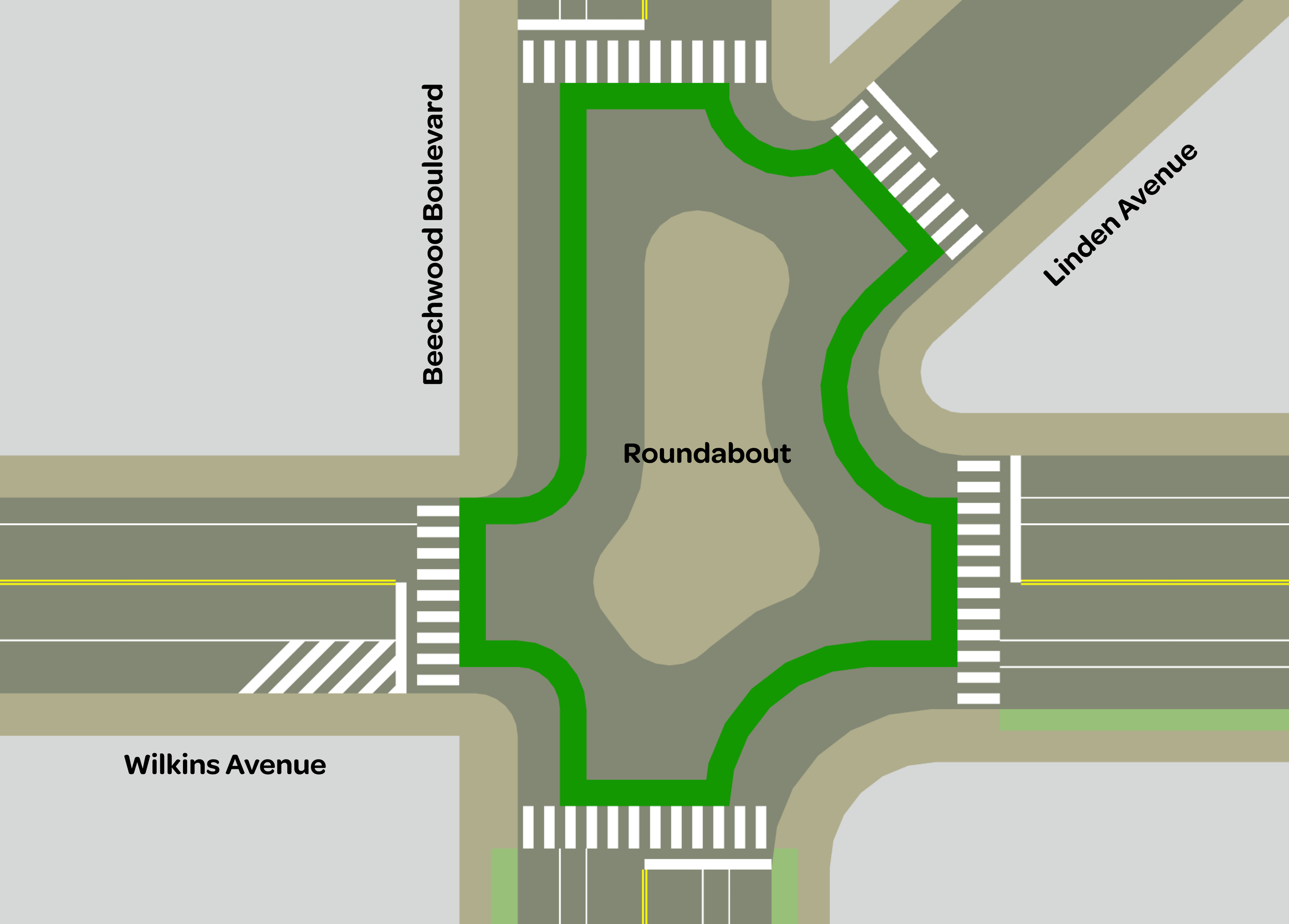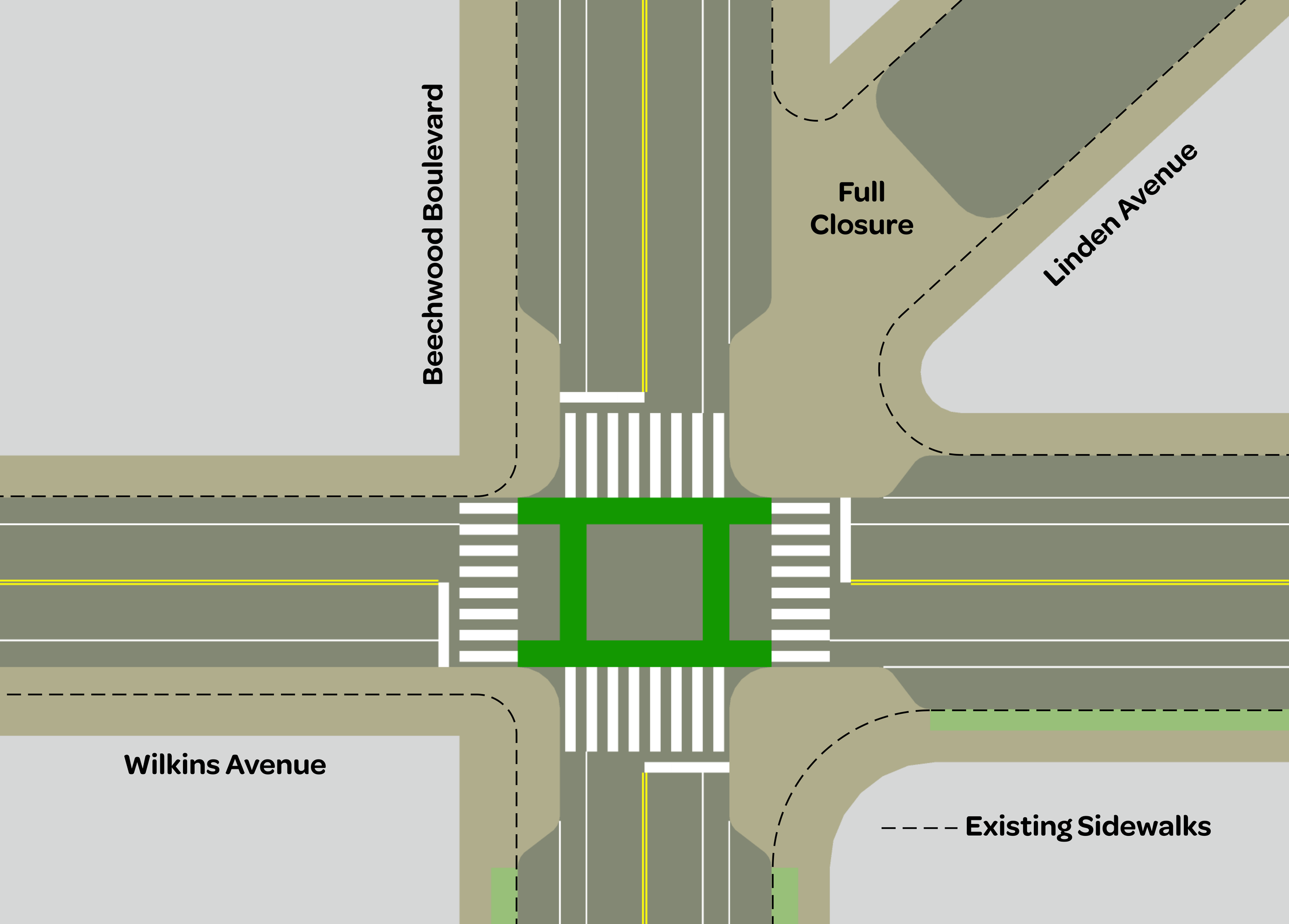How to Fix Dangerous 5-Way Intersections
Beechwood Boulevard, Wilkins Avenue, and Linden Avenue. The crash occurred in the crosswalk at the center of the image.
On February 9th, a person was crossing Beechwood Boulevard in the north crosswalk at Wilkins Avenue in Squirrel Hill. A driver turning left from Wilkins onto Beechwood hit them in the crosswalk. The pedestrian was taken to the hospital in critical condition.
Beechwood and Wilkins is a bad intersection. KDKA quoted neighbor Mudge Finkel as saying, “Sadly, I wasn't surprised, because we are always worried about that crosswalk.” Another neighbor, Ann Belser, said, “You never have a break as a pedestrian.” In response to the crash, Councilperson Erika Strassburger said, “We do all we can by adding traffic calming as we can, redoing the signals. What we really need to focus on now is enforcement.”
But enforcing what? Witnesses said that the driver had a left-turn arrow, permitting their movement. Would enforcement be targeted at the pedestrian? Multiple neighbors mentioned that the crosswalk is long and the crossing time is short; the pedestrian may have made what seemed like a reasonable decision given an inherently unsafe intersection. The people aren’t the problem; the issue is the intersection.
Existing Intersection
The intersection of Beechwood Boulevard, Wilkins Avenue, and Linden Avenue is a five-way intersection. Each leg is signal-controlled, and the western leg of Wilkins Avenue has a protected left turn lane. The turn radii on several of the legs are overly wide, leading to long crosswalks, the longest of which is technically through the center of the intersection (note the location of the stop bars on the north leg of Beechwood and on Linden). This long crosswalk is where the pedestrian was injured.
This may seem like common sense, but a crosswalk running through the middle of an intersection (unless it has a pedestrian scramble phase) is pretty unsafe. So we are going to look at several options that will fix this, first by moving the official crossings to the edges of the intersection, and second by turning this five-way intersection into a four-way.
Irregular Roundabout
Our first option uses an irregular roundabout to force all modes of traffic to the edges of the intersection. The left turn lane from Wilkins is eliminated, as is the central crosswalk, while a new one is added on the northern leg of Beechwood. Bicycle lanes are extended through the intersection to make it more clear which areas are intended for drivers and which are not.
The most obvious characteristic of this design is the lumpy roundabout (I think it looks like a nose: noseabout?). While irregular roundabouts are rare, they are far from unheard of, as can be seen in Crewe’s “eggabout” or the proposed “peanutabout” in Cambridge. It would take people smarter than me to figure out how to build it, but just because it’s not in a manual doesn’t mean it should be passed over.
Roundabouts slow traffic down, but they don’t bring it to a stop, instead encouraging slow, continuous flow. A design like this would cause the most trouble for westbound drivers on Wilkins Avenue, as they would be forced to go north approximately 60 feet out of their way. I know, horror of horrors.
One issue is that, with the long crosswalk eliminated, many pedestrians would not make the effort to head north or south to the edge of the intersection, and rather would simply travel straight across the roundabout. This would be a safety improvement. Pedestrians would only have to look one way for cars, and the single 75-foot crossing would be replaced with two 25-foot crossings. This could also be formalized, like on the peanutabout, which includes raised crosswalks through the center of the roundabout.
The size and shape of the roundabout indicate how much space in the middle of the intersection is wasted in order to let drivers take the shortest route, at the expense of everyone else. A roundabout like this could provide for a place making opportunity. An active neighborhood group could turn this space into a garden or an opportunity for art. It is large enough that it could be used to host special events. When we stop assuming that cars are the highest and best use for road space, many other options become available.
Another thing one might notice is that there is a lot of wasted space between the bike lanes and sidewalks. I’ll note that, similar to the space in the center of the intersection that could be turned over to the roundabout, that wasted space is there today, and eliminating that would go a great way to making the intersection safer. To that end, let’s take a look at a more efficient intersection.
Bumpouts
In this version, we use bumpouts to reduce the wasted space and shorten crossing distances for pedestrians. With the turn lane on Wilkins removed, we can widen the sidewalk to give pedestrians more space, as well as turn the sharrow into a real bike lane. Probably most importantly, the stop bar on the north leg of Beechwood Boulevard has been brought down to Wilkins Avenue, turning it into a four-way intersection. In this instance, Linden Avenue is downgraded from a part of the intersection to a side street where drivers would have to stop before entering the southbound lane of Beechwood. While this would simplify things in many instances, people driving south on Linden could be confused and could introduce unsafe behavior into the intersection. There are a variety of things we could do to reduce confusion.
Right-In/Right-Out (RIRO)
For example, a right-in/right-out (RIRO) island could be added on Linden Avenue. The intention of this would be to allow people to turn right from Beechwood onto Linden, and right from Linden onto Beechwood, but not to turn left. This would eliminate much of the confusion at the intersection while only inconveniencing the few people who want to get from Linden to Wilkins Avenue or South Beechwood Boulevard, who would be forced to go one block out of their way to Hastings Street, adding mere seconds to their travel time.
The issue with this is that some people are lazy and terrible, and would go around the island and turn left onto Beechwood Boulevard. Our next example would address that.
Partial Closure
To reduce the likelihood of people misusing the RIRO, a partial closure could be implemented. This would entirely prevent people from traveling south on Linden Avenue to Beechwood Boulevard while allowing people to turn from Beechwood onto Linden. This would reduce conflict significantly while still allowing emergency access, and potentially allowing for some public placemaking. But even with this, it would still be physically possible for the worst drivers to go the wrong way on Linden. This leaves us only one more stringent option: the full closure.
Full Closure
Finally, a full closure would fully eliminate the conflict coming from Linden Avenue. It could be designed to be mountable to maintain emergency access. Combined with a large bumpout, it would essentially provide a plaza similar in size to the roundabout in our first example, allowing for all the placemaking opportunities discussed there.
All of these options, as well as probably several others, would make this intersection safer. All of them take time to design, and money to build. Beechwood Boulevard and Linden Avenue are both owned by the City of Pittsburgh and administered by the Department of Mobility and Infrastructure, or DOMI. The folks at DOMI understand the importance of traffic calming and pedestrian safety and would love to improve an intersection like this (disclosure: I am a former DOMI employee), but they don’t have a dedicated funding stream. It would be up to Councilperson Strassburger to request funding from the City’s capital budget to fund improvements here. Please contact her here to ask about improving this intersection.
This is further complicated by the fact that Wilkins Avenue is owned by PennDOT District 11. They have a much worse record when it comes to pedestrian safety; over half of pedestrian and cyclist fatalities in Greater Pittsburgh happen on PennDOT roads. For them to prioritize pedestrian safety over vehicle throughput takes significant political pressure. Councilperson Strassburger can be an avenue for this pressure. District 11 can also be contacted directly here, and PennDOT Headquarters in Harrisburg can be contacted here. In addition, state-level representatives can apply pressure to fix problematic roads. Those representatives for this area include House Representative Dan Frankel (who can be contacted here) and Senator Jay Costa (who can be contacted here).
Please reach out to these people and organizations to pressure them to improve this intersection, so that we won’t see a similar crash at this location in the future.








